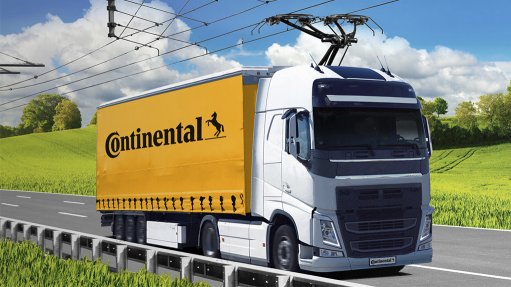
Continental’s development and production service provider, Continental Engineering Services (CES), and Siemens Mobility, have announced that they are collaborating in the development and production of current collectors for trucks, or, so-called pantographs, similar to those seen above some trains in South Africa.
The aim is to electrify key sections of the European highway network with an overhead line system, thereby reducing the carbon emissions from trucks.
The partnership brings together the expertise of two worlds – Siemens Mobility is a specialist in rail electrification, while CES is a development and production service provider for automotive technologies.
Both companies are now pooling their expertise in order to achieve volume production of current collectors quickly, thus making them available for widespread use in Europe.
The aptly named eHighway technology will supply trucks with electric drives (such as hybrid, fuel-cell, or battery-powered electric trucks) on heavily frequented stretches of highway via an overhead cable.
Trucks can drive completely electrically while also charging their batteries without consuming fuel.
“We are transferring the principle of rail electrification to the road,” says CES MD Dr Christoph Falk-Gierlinger.
“The current collectors will be developed and produced in accordance with automotive standards.
“The partnership between CES and Siemens Mobility is a major step toward climate-neutral freight transport.”
The eHighway technology developed by Siemens Mobility is ready for use today, says the company.
It is just a matter of developing the current collectors, especially for trucks, so that they can be offered to commercial vehicle manufacturers cost-effectively and in any desired number of units.
“Road haulage plays a central role in the battle against climate change,” notes Siemens Mobility CEO Michael Peter.
“In Germany, it causes one-third of the transport sector’s carbon dioxide emissions.
“With the eHighway, Siemens Mobility has already created a ready-to-use technology for energy-efficient, cost-effective and emission-free truck traffic that can be combined with other drives. This may become the backbone for environmental protection in road haulage.”
Focused Approach
The key to the eHighway is that not all highway kilometres need to be electrified.
The “National Platform for the Future of Mobility,” an innovation initiative of the German Federal Ministry of Transport, recommends that 4 000 km of highway be equipped with overhead cable technology by 2030.
This is because around two-thirds of fuel consumption by long-distance truck traffic on German highways takes place on the most frequently used 4 000 km of the 13 000-km-long network.
By electrifying the core network and supplying electricity to the trucks with electric drives, it is believed that a “huge and quick contribution” to climate protection can be achieved.
The solution with electricity from the overhead line corresponds to the rail principle, where only around 60% of the German rail network is equipped with overhead cables.
However, these are the key sections, which means that more than 90% of rail traffic in Germany rolls over the rails with electricity from overhead lines.
According to a study by the Federal Ministry of Transport, the electrification of German road haulage on a core network of 4 000 km could reduce carbon emissions by 10-million to 12-million tons a year when electricity is obtained from regenerative sources.
In Germany, the eHighway is already being tested on three public field trials.
CES and Siemens Mobility says they aim to make the truck overhead line system available across Europe.